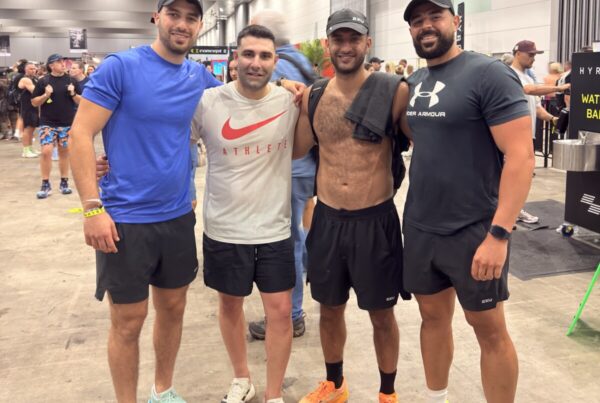The eight HYROX stations make or break your race. Each one challenges a different combination of strength, endurance, coordination and pacing under fatigue. Improving at HYROX isn’t just about working hard. It’s about understanding how each station works, how to train for it, and how to execute it intelligently on race day.
This guide walks through the right technique, how to structure training during the week, and the strategy’s you need to use on race day to save minutes.
Wall Balls
Wall balls are one of the best engine movements in HYROX. They spike your heart rate as much as running, and they reward efficiency far more than brute strength. Most athletes should include them two to three times per week, typically in sets of 15–25 built into conditioning workouts. They’re extremely potent, but very easy to overdo. Once you exceed your recoverability, they tend to set you back rather than push you forward. Gradually increasing weekly volume is key, aiming eventually for 200–300 total reps per week.
Although training heavy wall balls has value, proficiency with the competition weight matters far more. You want to be fast, efficient and technically smooth before adding load. A good benchmark is being able to hit 50 unbroken with your race weight. If you go heavier too early, you’ll sacrifice the volume needed to build shoulder endurance and speed. Far out from race day, one weekly heavier session is fine. However, in the final month, everything should return to race weight and race speed.
Good mobility makes wall balls dramatically easier. Limited ankle mobility forces your chest to fall forward, making the movement more taxing. Squatting on a wedge, knee-to-wall drills, couch stretches, and deep squat holds all help restore a better position. Thoracic and lumbar mobility also matter. A stiff back leaks energy. Even though shoulder mobility isn’t a huge limiter, simple generic mobility exercises for these areas will help in the wall balls, as well as the other stations and running.
For strength work, front-loaded squats, kettlebell goblet squats, and jump squats build leg drive, while landmine presses, and sometimes heavy other times light dumbbell presses improve upper-body strength and endurance.
On race day, pacing is everything. Know your realistic threshold and stay just below it. Have small benchmarks to continuously hit. E.g. 15 repetitions at a time then a 5 second rest. Breathing should flow continuously rather than using breath-holding like heavy squats. Inhale as you descend, exhale as you come up. To slow the arm burn, avoid leaving your arms overhead waiting for the ball; bring them back down to your chin between reps. A quick, snappy descent saves time, but don’t overdo it to the point you burn out early. Catching the ball while you’re descending is time saving too. The final station is an emotional battle as much as a physical one. Knowing where you are in the rep count helps you stay mentally anchored.
Sled Pulls
The sled pull is far more of a leg exercise than people expect. Efficiency starts with rope management: clear your landing zone behind you so you can walk backwards without tangling yourself. Begin with your elbows straight, lean back into the rope. Make sure all slack is taken up in the rope before leaning back. Let your hips open and walk backwards as the primary driver. Only at the end of each pull do you bend your arms and bring the rope in with a snappy powerful movement. Then leave the rope to one side. At the end of every pull (making sure you walk from the front of the box to the back), drop the rope down. Then take those few steps forward and pick it up from the front of the box again. Arm-over-arm pulling isn’t efficient. The legs should do the work.
Train the pull twice a week. One session with sets and reps, and one session inside a HYROX simulation. Keep every pull fast and crisp. You can train slightly heavier than race weight, but only by about 10 kg. Moving a lot more slowly defeats the purpose.
Strength work like rack pulls, deadlifts (with a horizontal torso lean), and heavy sled drags using a TRX strap build strength with similar patterns.
On race day, transitions are where athletes lose the most time. Run hard into the station, grab the rope immediately, and start pulling. Be aggressive on every pull. Explosiveness reduces time under tension. You’ll need to conserve some energy on the run before the sled, and avoid redlining on the SkiErg, so that you have enough left to attack this station.
Sled Push
The sled push is one of the most feared parts of HYROX, but with good technique it becomes far more manageable. Two sessions per week work well, with one being classic sets and distances (e.g. 150 m of total pushing) and the other inside a simulation. Similar to sled pull.
Technique matters enormously. Place your hands forward on the poles with your forearms braced and in contact with the poles, bringing your hips and feet close to the sled. To get into this position, you’ll be almost perpendicular with the bars and quite bent over. This shortens the lever and makes the push easier. Experiment with stride length to find the fastest pattern that doesn’t spike fatigue. Most people do best with shorter, fast steps rather than long drives.
Strategically, you must enter and exit the sled under control. Many athletes destroy their race by sprinting into the sled or pushing the first 12.5 metres of the sled too aggressively. Break the segment into halves or quarters, or push until your legs are just about to flood with blood and then rest. Take 5–10 seconds of rest between sections and maintain consistent effort.
Burpee Broad Jumps
Pacing the burpee broad jumps begins with knowing your reps. If you plan to reset every five reps or so, stick to it consistently. Most athletes should rest while on the floor or in a low kneeling position rather as this drops heart rate. If you stop after jumping, then bend over with your hands or arms on your elbow, this can help muscles in your neck and shoulder region that usually don’t help with breathing get involved. I would early on stop on the floor and then later stop with hands on knees.
A step-up from the burpee is far more efficient than hopping up, especially in singles. Jumping to your feet wastes energy and should only be used by elite athletes chasing seconds. Place your hands about 30 cm in front of your foot before kicking your legs back. Then bring one of your feet right up against your planted hand, and then have the other foot follow. This is on the way up. Keeping your head up opens your airways and helps maintain rhythm.
When dropping to the floor, don’t over-control the descent. A looser drop saves energy, but don’t let it escalate your pace unintentionally. Extend your legs slightly just before landing on each jump to gain small increments of distance. At the turnaround line, if your landing from the jump is going to be close, turn your feet sideways to increase your chance of clearing it without having to drop down for an extra rep.
Because burpees are low load, you can train them three to four times a week in different intensities and formats, building both speed and pacing intuition.
Farmers Carry
The farmer’s carry is essentially a speed walk under load. The key is posture. You want full hip extension and a natural trunk rotation. Bracing hard through your core restricts thoracic rotation and limits your breathing. Lean forward slightly with your chest proud and keep the kettlebells slightly behind your body rather than them pulling you forward. Avoid shrugging the shoulders as this fatigues your traps and makes later stations (lunges and wall balls) harder.
Strong hands are crucial. Turning your pinkie slightly upwards engages your lats and creates a more stable grip. Training wrist flexors and extensors several days per week including hammer curls, reverse curls, wrist extensions, dead hangs help build the endurance needed to avoid dropping the bells.
Mix heavier carries, lighter fast carries, and race-weight practice in training. These are also low load so you can train them three to five times a week.
Ski Erg
The Ski Erg is a hinge movement. The most powerful part of the stroke is at the top, so you want a sharp, aggressive drive using your chest, hips and full body weight. Drive your chest down as you push your bottom backwards and then follow through with a fast pulldown. Keep your shoulders relaxed at the top instead of shrugging for extra range. That shift puts the lats in a weaker position. Turn the pinkies inwards slightly, throw the chest forward, and think of pushing your body down rather than pulling with your arms. On race day, go a little easier than you think. This is where many athletes burn themselves out. Just like the rower, going a lot harder here isn’t going to make you a lot faster. Efficiency here is key. You get free meters here in between strokes. That doesn’t happen when running or in the other stations. You can adjust the settings to view the force curve of each stroke.
The force curve should look like a mountain: a high spike at the start, then fading gradually. The Ski Erg can be trained a lot, there’s no real impact. It too can be done three to five days a week. It’s well used in simulations or just in low load machine zone 2 sessions to build aerobic base, along with the rower, bike, assault bike and cross-trainer.
Lunges
Lunges are arguably the hardest station, especially the last run that you have after. Place the weight on your back, not the front. Front-loaded lunges pull your ribs downward and make breathing inefficient, forcing your lower back also to over-extend to stay upright. With the bag on your upper back, the load stays centred over your hips, allowing your glutes to do more of the work.
Your breathing should stay smooth and deliberate: inhale as you descend, exhale as you rise. Cadence changes depending on fatigue. Step-through lunges are faster and more powerful, while step-to lunges reduce muscular load and help you get through the station, reducing the chance your legs are flooded with lactic acid. Step to means after the lunge, put your backfoot next to the foot that was just the front foot on the lunge, before then taking the next step.
Walking lunges should be trained frequently to build leg endurance and mental resilience. 100-200m a week is good. Once in a simulation (competition weight), one for sets and reps e.g 3x15m heavier weight, 2x20m lighter weight.
Rower
Like the Ski Erg, this should feel controlled. Use a slow stroke rate with strong power at the start of each pull, as that’s where most of the distance is made.
Start the pull with your legs, then transition to hip extension, and finish with your arms. On the recovery, keep your arms low and relaxed, and stay upright so you can generate power on the next stroke. HYROX usually uses newer, less worn-in machines, so the pull feels heavier. Dropping the damper setting slightly on race day is a smart adjustment.
Click here to read about the science behind getting faster at HYROX!






This is an incredibly detailed and practical guide! The advice on pacing and technique for the Sled Push and Wall Balls is gold for anyone tackling a HYROX race.